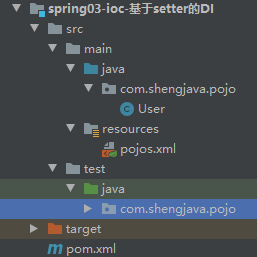一、基于setter的依赖注入
项目结构

创建一个用户类,只有一个无参构造器。
一定要生成set方法!因为property标签进行注入时,使用的是setXxx()方法进行注入的。所以该文章标题取名为“依赖注入(基于setter)”。
public class User {
private String name;
public User() {
}
@Override
public String toString() {
return "User{" +
"name='" + name + '\'' +
'}';
}
public String getName() {
return name;
}
public void setName(String name) {
this.name = name;
}
}
设置配置文件。
<?xml version="1.0" encoding="UTF-8"?>
<beans xmlns="http://www.springframework.org/schema/beans"
xmlns:xsi="http://www.w3.org/2001/XMLSchema-instance"
xsi:schemaLocation="http://www.springframework.org/schema/beans
https://www.springframework.org/schema/beans/spring-beans.xsd">
<!-- 第一种,使用value属性注入 -->
<bean id="user1" class="com.shengjava.pojo.User">
<property name="name" value="长生"/>
</bean>
<!-- 第二种,property标签下的ref引用注入(ref的值为其他bean的id) -->
<bean id="user2" class="com.shengjava.pojo.User">
<property name="name">
<ref bean="str"/>
</property>
</bean>
<bean id="str" class="java.lang.String">
<constructor-arg type="java.lang.String" value="长生"/>
</bean>
</beans>
编写测试类
public class UserTest {
@Test
public static void main(String[] args) {
// create and configure beans(现在我们的对象都是Spring进行管理了,我们可以去Spring的容器ApplicationContext中获取。context:上下文、环境的意思)
ApplicationContext context = new ClassPathXmlApplicationContext("pojos.xml");
// retrieve configured instance(从上下文context中获取对象)
User user1 = context.getBean("user1", User.class);
User user2 = context.getBean("user2", User.class);
System.out.println(user1);
System.out.println(user2);
}
}
输出
User{name='长生'}
User{name='长生'}
更多依赖注入例子,请查看:
Examples of Dependency Injection
二、注入复杂类型
依赖注入可以注入多种类型如:
- 直接值(或字面量,上面xml中的第一种方式)
- ref引用其他bean(上面xml中的第二种方式)
- 内部的bean
- 数组
- 集合
- 空字符串和null
- p-namespace
- c-namespace
- 复合属性名
上面案例中,已经演示了两种类型的注入:1.直接值。2.ref引用其他bean
接下来做一个复杂类型的注入案例。
项目结构:
[外链图片转存失败,源站可能有防盗链机制,建议将图片保存下来直接上传(img-aANrYMaa-1586069559788)(BE908BF815B5469CAB6B06D04F352F64)]
创建地址类
public class Address {
private String address;
@Override
public String toString() {
return "Address{" +
"address='" + address + '\'' +
'}';
}
public String getAddress() {
return address;
}
public void setAddress(String address) {
this.address = address;
}
}
创建学生类
public class Student {
private String name;
/** 现住址 */
private Address address;
/** 籍贯 */
private Address nativePlace;
private String[] books;
private List<String> hobbies;
private Map<String, String> card;
private Set<String> games;
private Properties info;
private String wife;
@Override
public String toString() {
return "Student{" +
" \nname='" + name + '\'' +
", \naddress=" + address +
", \nnativePlace=" + nativePlace +
", \nbooks=" + Arrays.toString(books) +
", \nhobbies=" + hobbies +
", \ncard=" + card +
", \ngames=" + games +
", \ninfo=" + info +
", \nwife='" + wife + '\'' +
'}';
}
public String getName() {
return name;
}
public void setName(String name) {
this.name = name;
}
public Address getAddress() {
return address;
}
public void setAddress(Address address) {
this.address = address;
}
public Address getNativePlace() {
return nativePlace;
}
public void setNativePlace(Address nativePlace) {
this.nativePlace = nativePlace;
}
public String[] getBooks() {
return books;
}
public void setBooks(String[] books) {
this.books = books;
}
public List<String> getHobbies() {
return hobbies;
}
public void setHobbies(List<String> hobbies) {
this.hobbies = hobbies;
}
public Map<String, String> getCard() {
return card;
}
public void setCard(Map<String, String> card) {
this.card = card;
}
public Set<String> getGames() {
return games;
}
public void setGames(Set<String> games) {
this.games = games;
}
public Properties getInfo() {
return info;
}
public void setInfo(Properties info) {
this.info = info;
}
public String getWife() {
return wife;
}
public void setWife(String wife) {
this.wife = wife;
}
}
设置studentBeans.xml配置文件
<?xml version="1.0" encoding="UTF-8"?>
<beans xmlns="http://www.springframework.org/schema/beans"
xmlns:xsi="http://www.w3.org/2001/XMLSchema-instance"
xsi:schemaLocation="http://www.springframework.org/schema/beans
https://www.springframework.org/schema/beans/spring-beans.xsd">
<!-- 地址bean -->
<bean id="address" class="com.shengjava.pojo.Address">
<property name="address" value="中国浙江"></property>
</bean>
<!-- 学生bean -->
<bean id="student" class="com.shengjava.pojo.Student">
<!-- 注入直接量 -->
<property name="name" value="张三"/>
<!-- 注入其他bean -->
<property name="address">
<ref bean="address"/>
</property>
<!-- 注入内部bean -->
<property name="nativePlace">
<bean class="com.shengjava.pojo.Address">
<property name="address" value="中国浙江"></property>
</bean>
</property>
<!-- 注入数组 -->
<property name="books">
<array>
<value>三体</value>
<value>三国志</value>
<value>三国演义</value>
</array>
</property>
<!-- 注入集合 -->
<property name="hobbies">
<!-- List -->
<list>
<value>吉他</value>
<value>篮球</value>
<value>街舞</value>
</list>
</property>
<property name="card">
<!-- map -->
<map>
<entry key="中国银行" value="111...111"/>
<entry key="农业银行" value="222...222"/>
<entry key="建设银行" value="333...333"/>
</map>
</property>
<property name="games">
<!-- set -->
<set>
<value>王者荣耀</value>
<value>绝地求生</value>
</set>
</property>
<property name="info">
<!-- Properties -->
<props>
<prop key="email">123@qq.com</prop>
<prop key="phone">188xxxx8888</prop>
</props>
</property>
<property name="wife">
<!-- 注入值为null -->
<null/>
</property>
</bean>
</beans>
编写测试类
public class StudentTest {
public static void main(String[] args) {
// 获取context
ApplicationContext context = new ClassPathXmlApplicationContext("studentBeans.xml");
// 获取对象
Student student = context.getBean("student", Student.class);
System.out.println(student);
}
}
输出
Student{
name='张三',
address=Address{address='中国浙江'},
nativePlace=Address{address='中国浙江'},
books=[三体, 三国志, 三国演义],
hobbies=[吉他, 篮球, 街舞],
card={中国银行=111...111, 农业银行=222...222, 建设银行=333...333},
games=[王者荣耀, 绝地求生],
info={phone=188xxxx8888, email=123@qq.com},
wife='null'}
以上就是复杂类型注入,详细参考自:1.4.2. Dependencies and Configuration in Detail
相关
我的该分类的其他相关文章,请点击:【Spring + Spring MVC + MyBatis】文章目录






















 882
882











 被折叠的 条评论
为什么被折叠?
被折叠的 条评论
为什么被折叠?








